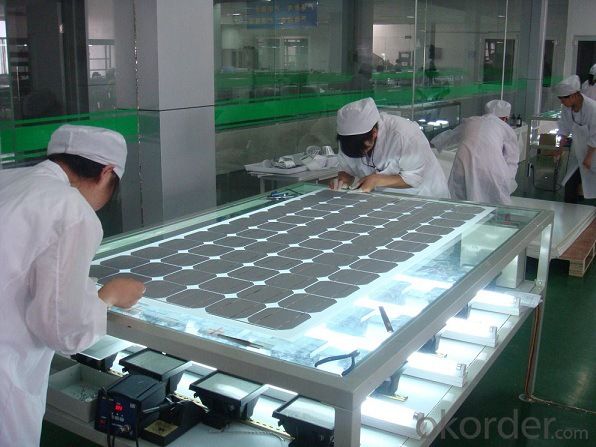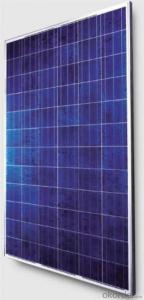CNBM Polycrystalline Solar Panels Made in China
- Loading Port:
- Shanghai
- Payment Terms:
- TT OR LC
- Min Order Qty:
- 78000 watt
- Supply Capability:
- 10000000 watt/month
OKorder Service Pledge
OKorder Financial Service
You Might Also Like

Poly-Crystalline solar panel, Poly 156 cell, 60pcs.Power range 230W-260W.
Quality and Safety
1. Rigorous quality control meets the highest international standards.
2. High-transmissivity low-iron tempered glass, strong aluminium frame.
3. Using UV-resistant silicon.
4. IS09001/14001/CE/TUV/UL
Warranties
1. 10 years limited product warranty
2. 15 years at 90% of the minimal rated power output
3. 25 years at 80% of the minimal rated power output
Technical date :
ITEM NO.: | Poly 156*156 cell ,60pcs . Power range from 230Wp-260Wp | ||||||
Maximum Power(W) | 230 | 235 | 240 | 245 | 250 | 255 | 260 |
Optimum Power Voltage(Vmp) | 29.4 | 29.5 | 29.7 | 30.1 | 30.3 | 30.5 | 30.7 |
Optimum Operatige Current(Imp) | 7.83 | 7.97 | 8.08 | 8.14 | 8.25 | 8.37 | 8.48 |
Open Circuit Voltage(Voc) | 36.7 | 36.8 | 36.9 | 37.1 | 37.3 | 37.5 | 37.7 |
Short Circuit Current(Isc) | 8.52 | 8.59 | 8.62 | 8.65 | 8.69 | 8.73 | 8.78 |
Solar Cell: | 156*156 Poly | ||||||
Number of Cell(pcs) | 6*10 | ||||||
Brand Name of Solar Cells | JA Cell, Bluesun Cell | ||||||
Size of Module(mm) | 1650*992*40/45/50 | ||||||
Cable & Connector Type | Pass the TUV Certificate | ||||||
Frame(Material Corners,etc.) | Aluminium-alloy | ||||||
Back sheet | TPT | ||||||
Weight Per Piece(KG) | 19.5KG | ||||||
FF (%) | 70-76% | ||||||
Junction Box Type | Pass the TUV Certificate | ||||||
Tolerance Wattage(e.g.+/-5%) | ±3%, or 0-3% | ||||||
Front Glass Thickness(mm) | 3.2 | ||||||
Temperature Coefficients of Isc(%) | +0.04 | ||||||
Temperature Coefficients of Voc(%) | -0.38 | ||||||
Temperature Coefficients of Pm(%) | -0.47 | ||||||
Temperature Coefficients of Im(%) | +0.04 | ||||||
Temperature Coefficients of Vm(%) | -0.38 | ||||||
Temperature Range | -40°C to +85°C | ||||||
Surface Maximum Load Capacity | 5400Pa | ||||||
Allowable Hail Load | 23m/s ,7.53g | ||||||
Bypass Diode Rating(A) | 12 | ||||||
Warranty | 90% of 10 years, 80% of 25 years. | ||||||
Standard Test Conditions | AM1.5 1000W/ 25 +/-2°C | ||||||
Packing | carton or pallet | ||||||
1*20' | 14 Pallets / 316pcs | ||||||
1*40'STD | 25 Pallets / 700pcs | ||||||
FAQ
I..Will you focus on the safety of the goods during transportation?
Yes, Safety of the cargo is the primary element that we would consider on transportation.
II..How would guarantee the quality will meet the requirements of your clients?
Before shipment, we will have inspection for each batch of goods.
III..What certificates do you have?
IEC,UL,TUV,CSA,etc.
IV..Can you do OEM according to clients’ requirements?
Yes, we have our own brand while we can provide OEM service
- Q:I'm curious, for those who have had solar panels installed on the rooves of their houses:How much did you pay? How much energy do the panels produce? Did it dramatically cut down on your electricity bill? Was it worth it? Thanks!
- I say yes, I had a system put in a few months ago. I paid $6K and my utility paid $0K. I should break even in about 6 years. The system is guaranteed for 25 years, so I will have at least 9 years of free energy. I went from a bill of around $200 per month to under $20 in the summer. I will pay a little more in the winter months because less daylight, but I don't use as much energy in the winter. Each year electricity goes up an average of 5%, so while my neighbors have a larger bill each month, I'll be staying under $50 for a long time. Even without the rebate I would have a break even time of about 0 years, still 5 years of free energy.
- Q:Solar panels would change the world if they were widely available to us especially cheap, it will be worth it in the long end. Money would be saved like housands a year per person on utility costs.
- Yes, solar panels could change the world if they were especially cheap--but they're not and may not be cheap for many years, if ever. Lots of new technology could change the world but most of it doesn't. The government doesn't have a very good track record of picking winners in the new technology markets; that's something we should probably leave to the venture capitalists to do--with their own money. The money the government spent on solar panels is gone. Racked up as debt that we'll leave to our children and grandchildren to pay off.
- Q:When you add a load resistor to a PV panel (Solar panel) of 00 ohms what happens to the voltage produced from the cellAlso, as the resistance increases, how does this affect the output voltage
- Photovoltaic cells have a load curve that gives the power conversion based on the current drawn. This makes it harder to calculate. For instance, at infinite resistance, the solar cell will have a peak voltage that produces no power (P=I*V=V^2/r). At short circuit, the voltage collapses to essentially nothing and so the power is almost nothing. There is an optimal load (sweet spot) where the resistance applied will draw the most power out of the cell while not overloading it. This measure is either given by the manufacturer or found experimentally. Upon taking a lit panel that has no load and applying a 00 ohm resistance, the voltage will drop. By how much is entirely dependent on the array layout and specific cell characteristics. As the resistance drops from the optimal load point, the voltage collapses fairly sharply. As the resistance increases from the optimal load point, the voltage will rise more at first and then level off to the peak or no-load voltage.
- Q:Can solar panels be used in areas with high levels of dust or dirt?
- Yes, solar panels can be used in areas with high levels of dust or dirt. However, the accumulation of dust and dirt on the surface of the solar panels can reduce their efficiency in generating electricity. Regular cleaning and maintenance may be required to ensure optimal performance in such areas.
- Q:How do solar panels affect the overall energy consumption of a building?
- Solar panels can significantly reduce the overall energy consumption of a building. By harnessing renewable energy from the sun, solar panels generate electricity, which can be used to power various appliances and systems within the building. This reduces reliance on traditional energy sources, such as fossil fuels, thereby lowering the building's energy consumption from the grid. Additionally, excess energy produced by solar panels can be stored in batteries or fed back into the grid, further offsetting the building's energy consumption. Overall, solar panels contribute to a more sustainable and energy-efficient building by reducing its overall energy needs.
- Q:Can solar panels be used for charging batteries?
- Yes, solar panels can be used for charging batteries. Solar panels convert sunlight into electricity, which can be used to charge batteries and store energy for later use. This process is commonly used in off-grid systems or to power portable devices and vehicles.
- Q:How much does it cost to replace a solar panel?
- The cost to replace a solar panel can vary depending on factors such as the type, size, and quality of the panel, as well as any additional installation costs. On average, the cost can range from a few hundred to several thousand dollars per panel. It is recommended to consult with a professional solar installer or company for an accurate estimate based on your specific needs.
- Q:Can solar panels be installed on schools or educational institutions?
- Yes, solar panels can be installed on schools or educational institutions. In fact, many schools and educational institutions have embraced solar energy as a sustainable and cost-effective solution for their energy needs. Installing solar panels on rooftops or open spaces of these institutions not only helps them save on electricity bills but also promotes environmental awareness and sets a positive example for students and the community.
- Q:I want to plug my solar system battery bank into my transfer switch on my cabin when not using a generator. The transfer switch will handle 220 volt from my generator. How do I get a 220 volt inverter that runs 60 hz or do all of them run 50 hz.I see plenty of 20 volt 60 hz. I'm at the point of needing to order one and I'm not sure.
- Sun okorder
- Q:Can solar panels be installed on a boat or yacht?
- Yes, solar panels can be installed on boats or yachts. In fact, they are becoming increasingly popular as a source of renewable energy for marine vessels. Solar panels can provide power for various onboard systems, such as lighting, electronics, and refrigeration, reducing the reliance on generators or shore power. Additionally, solar panels are lightweight, durable, and can be easily installed on the deck or roof of a boat or yacht, making them a practical and efficient choice for harnessing clean energy at sea.
1. Manufacturer Overview |
|
|---|---|
| Location | |
| Year Established | |
| Annual Output Value | |
| Main Markets | |
| Company Certifications | |
2. Manufacturer Certificates |
|
|---|---|
| a) Certification Name | |
| Range | |
| Reference | |
| Validity Period | |
3. Manufacturer Capability |
|
|---|---|
| a)Trade Capacity | |
| Nearest Port | |
| Export Percentage | |
| No.of Employees in Trade Department | |
| Language Spoken: | |
| b)Factory Information | |
| Factory Size: | |
| No. of Production Lines | |
| Contract Manufacturing | |
| Product Price Range | |
Send your message to us
CNBM Polycrystalline Solar Panels Made in China
- Loading Port:
- Shanghai
- Payment Terms:
- TT OR LC
- Min Order Qty:
- 78000 watt
- Supply Capability:
- 10000000 watt/month
OKorder Service Pledge
OKorder Financial Service
Similar products
New products
Hot products
Hot Searches
Related keywords




























